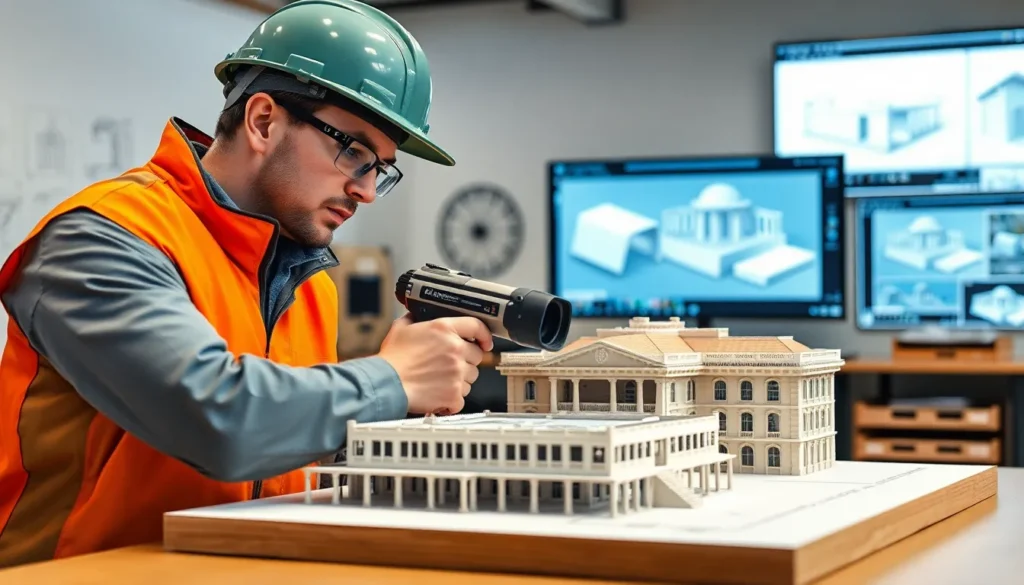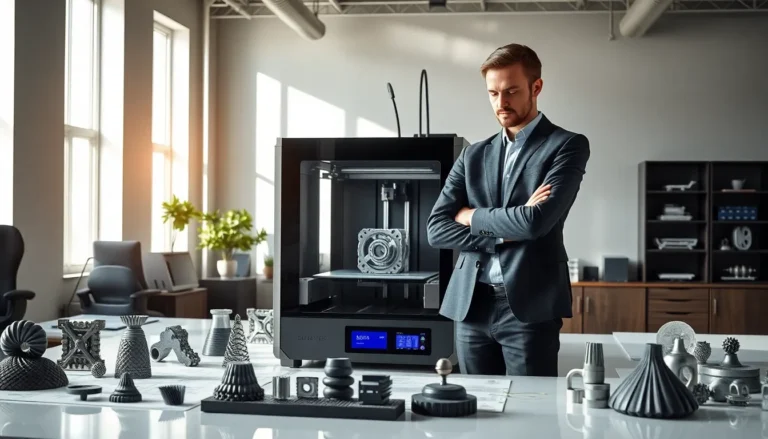Table of Contents
ToggleIn a world where selfies reign supreme, 3D scanning technology is here to take things to a whole new dimension—literally! Forget the days of flat images and boring measurements. This cutting-edge tech transforms real-world objects into digital masterpieces faster than you can say “cheese.” Whether it’s capturing the intricate details of a sculpture or mapping out an entire building, 3D scanning is revolutionizing industries from architecture to healthcare.
Overview of 3D Scanning Technology
3D scanning technology captures real-world objects and transforms them into detailed digital representations. This process employs various techniques such as laser scanning, structured light scanning, and photogrammetry. Each method contributes unique features and advantages, influencing how industries implement 3D scanning solutions.
Laser scanning utilizes laser beams to measure distances, creating precise point clouds that represent the scanned object. With this technology, professionals in architecture can generate accurate site surveys and create digital twin models. On the other hand, structured light scanning employs patterns of light projected onto objects. This approach allows for rapid data acquisition, making it a popular choice in product design.
Photogrammetry distinguishes itself by utilizing multiple photographs taken from different angles. Software analyzes these images and reconstructs 3D models, which can work effectively in fields like cultural heritage preservation. High-resolution textures attached during this process enhance the visual fidelity of the digital models.
Industries benefit greatly from adopting 3D scanning technology. In manufacturing, it streamlines quality control and production processes. Similarly, healthcare utilizes 3D scanning to plan surgeries and create custom prosthetics. Architects and engineers rely on this technology for efficient project development and collaboration.
Considerable advancements in 3D scanning have resulted in more accessible tools and software. These innovations drive widespread adoption across various sectors, enhancing accuracy and efficiency in workflows. With its ability to capture intricate details, 3D scanning technology transforms the way industries approach their objectives, making it a vital component in today’s digital landscape.
Types of 3D Scanning Technology

3D scanning technology encompasses various methods, each suitable for distinct applications. These methods include contact scanning and non-contact scanning.
Contact Scanning
Contact scanning involves direct contact between the scanner and the object. This technique utilizes probes to capture precise surface geometry. Typically, this method suits applications requiring high accuracy, such as industrial measurement and quality control. Many manufacturers employ contact scanners to inspect complex parts and ensure their conformity with specifications. Notably, contact scanning excels in capturing minute details that might be overlooked by other methods, making it essential for industries that prioritize precision.
Non-Contact Scanning
Non-contact scanning enables data capture without physical interaction with the object. Techniques such as laser scanning and structured light scanning form the basis of this method. Non-contact scanners collect surface data quickly, making them ideal for large objects and projects with short timelines. Professionals use non-contact scanning in fields like architecture, aerospace, and cultural heritage preservation. By offering rapid data acquisition and detailed surface models, non-contact scanning enhances efficiency and accuracy across various applications.
Applications of 3D Scanning Technology
3D scanning technology finds diverse applications across industries, enhancing processes and outcomes significantly.
Industrial and Manufacturing
In manufacturing, 3D scanning plays a crucial role in quality control. Companies use it to check part dimensions against CAD models, ensuring precision in production. This accuracy reduces errors and saves time in rework. Moreover, 3D scanning streamlines reverse engineering by capturing the geometry of existing products, facilitating design improvements. Manufacturers also benefit from rapid prototyping, as scanned data allows for quick iterations. Advanced scanning systems enable thorough inspections without halting production lines. Overall, these applications contribute to efficient manufacturing workflows, making technology indispensable in industrial settings.
Healthcare and Medicine
Healthcare professionals leverage 3D scanning technology for various applications. Surgeons use it for pre-operative planning, where 3D models assist in visualizing complex anatomy. This practice enhances surgical accuracy and outcomes. Custom prosthetics and implants also emerge from 3D scanned data, ensuring personalized treatments. Patients receive solutions tailored to their unique anatomies, significantly improving comfort and functionality. Furthermore, medical education benefits from 3D scanning by providing realistic anatomical models for training. Such applications demonstrate how 3D scanning transforms healthcare, fostering innovation and improving patient care.
Entertainment and Gaming
In the entertainment and gaming industry, 3D scanning technology revolutionizes content creation. Developers create realistic characters and environments through detailed scans of real-world objects and people. This method enhances visual fidelity, making games more immersive. Film studios utilize 3D scanning for visual effects, capturing actor performances to create lifelike animations. Additionally, virtual reality experiences gain depth and realism through scanned data, engaging audiences on new levels. As technology evolves, its applications in entertainment and gaming continue to grow, shaping the future of interactive media.
Advantages of 3D Scanning Technology
3D scanning technology offers significant benefits across various fields. It enhances precision and boosts efficiency in workflows.
Precision and Accuracy
Precision defines 3D scanning technology. It captures intricate details of real-world objects, producing digital models with unrivaled accuracy. Laser scanning, for example, generates point clouds with high-resolution data, essential for site surveys in architecture. This method minimizes errors during measurements and ensures reliable results. Structured light scanning also excels in capturing contours and shapes while maintaining accuracy for product design. Non-contact techniques eliminate the risk of damaging sensitive surfaces, making it suitable for various applications. Industries relying on precise data can count on 3D scanning to meet rigorous standards.
Time and Cost Efficiency
Time savings mark another key advantage of 3D scanning technology. Rapid data acquisition enables quick turnarounds on projects, reducing overall lead times in manufacturing and design. Companies that implement 3D scanning streamline quality control processes, allowing for faster identification of defects. Cost reductions emerge through fewer errors and less wasted material during production stages. Furthermore, medical professionals benefit significantly from this efficiency when planning surgeries or creating custom prosthetics, cutting down on preparation time. Adopting 3D scanning technology translates to both time and cost savings, promoting enhanced organizational productivity.
Challenges and Limitations
3D scanning technology faces several challenges that impact its effectiveness in various applications. These challenges can affect its adoption across industries.
Technical Constraints
Technical limitations often hinder the full potential of 3D scanning. Data acquisition can be sensitive to environmental conditions, and factors like lighting and surface reflectivity can distort results. Complex geometries sometimes present obstacles, leading to incomplete scans. Additionally, certain materials may require specific scanning techniques to achieve optimal results. Scanners also possess a limited range; some models excel at capturing small objects while struggling with larger structures. Accuracy varies based on technique, equipment quality, and the operator’s skill. Each factor presents a challenge that professionals must navigate for precise outcomes.
Cost Considerations
Cost remains a significant barrier for many organizations considering 3D scanning. High-quality scanners often come with a steep price tag, which may deter smaller businesses from investing. Maintenance and calibration add to ongoing expenses, requiring trained personnel to operate the equipment effectively. Software licenses for processing and analyzing scanned data can also accumulate costs, impacting budgets for projects. In competitive industries, these financial constraints can limit innovation and slow adoption rates. Evaluating the return on investment becomes crucial for businesses to justify the expense of implementing this technology.
3D scanning technology is reshaping industries by providing unparalleled precision and efficiency. Its ability to create detailed digital models from real-world objects not only streamlines processes but also enhances collaboration across various fields. As advancements continue to make this technology more accessible, businesses are increasingly recognizing its value in improving workflows and reducing costs.
Despite some challenges related to environmental factors and financial constraints, the benefits of 3D scanning far outweigh the drawbacks. This technology is poised to play a critical role in the future of design, manufacturing, and healthcare, making it an essential tool for innovation in today’s digital era.




